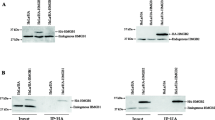Abstract
Defective DNA mismatch repair results from genetic or epigenetic alterations that most frequently inactivate the genes hMLH1 and hMSH2. This is thought to promote tumourigenesis by accumulation of mutations in oncogenes and tumour suppressor genes. This pathway, first reported in colon cancer, has been recently demonstrated in a subgroup of sporadic pancreatic adenocarcinomas. Intraductal papillary-mucinous neoplasms of the pancreas are a special type of pancreatic tumours, characterised by a spectrum of morphological changes from mild to moderate and to non-invasive, and they may associate with adenocarcinoma. An immunohistochemical study of hmlh1 and hmsh2 protein expression was performed on 26 intraductal papillary-mucinous neoplasms. All tumours showed nuclear expression of hmlh1 and hmsh2 proteins. There were two distinctive patterns of protein expression on the basis of the location of cells expressing these markers: the “normal” pattern, observed mainly in adenoma and rarely in intraductal papillary-mucinous neoplasms with moderate dysplasia and the “dysplastic” pattern, frequently encountered in moderate dysplasia neoplasms, non-invasive and invasive carcinomas. These findings suggest that defective DNA mismatch repair, due to inactivation of hMLH1 and hMSH2, does not play a significant role in the pathogenesis of intraductal papillary-mucinous neoplasms of the pancreas. Two patterns of protein expression were observed and were correlated with the progression of dysplasia in intraductal papillary mucinous neoplasms.



Similar content being viewed by others

References
Biankin AV, Biankin SA, Kench JG et al (2002) Aberrant p16 and DPC/Smad4 expression in intraductal papillary mucinous tumours of the pancreas is associated with invasive ductal adenocarcinoma. Gut 50:861–868
Bonte H, Fléjou JF (2003) Patterns of expression of MMR proteins in serrated adenomas and other polyps of the colorectum. Gut 52:611
Brown KD, Rathi A, Kamath R et al (2003) The mismatch repair system is required for S-phase checkpoint activation. Nat Genet 33:80–84
Duval A, Hamelin R (2002) Mutation at coding repeat sequences in mismatch repair-deficient human cancers: toward a new concept of target genes for instability. Cancer Res 62:2447–2454
Fuji H, Inagaki M, Kasai S et al (1997) Genetic progression and heterogeneity in intraductal papillary mucinous neoplasms of the pancreas. Am J Pathol 151:1447–1454
Goggins M, Offerhaus GJ, Hilgers W et al (1998) Pancreatic adenocarcinomas with DNA replication errors (RER+) are associated with wild-type K-ras and characteristic histopathology. Poor differentiation, a syncytial growth pattern, and pushing borders suggest RER+. Am J Pathol 152:1501–1507
Hamilton SR, Aaltonen LA (eds) (2000) Pathology and genetics of tumours of the digestive system. IARC Press, Lyon
Kloppel G (1998) Clinicopathologic view of intraductal papillary mucinous tumour of the pancreas. Hepatogastroenterology 45:1981–1985
Kloppel G, Solcia E, Longnecker DS et al (eds) (1996) Histological typing of tumours of the exocrine pancreas. Springer, Berlin Heidelberg New York
Kondo E, Furukawa T, Yoshinaga K et al (2000) Not hMSH2 but hMLH1 is frequently silenced by hypermethylation in endometrial cancer but rarely silenced in pancreatic cancer with microsatellite instability. Int J Oncol 17:535–541
Lindor NM, Burgart LJ, Leontovich O et al (2002) Immunohistochemistry versus microsatellite instability testing in phenotyping colorectal tumours. J Clin Oncol 20:1043–1048
Luttges J, Beyser K, Pust S et al (2003) Pancreatic mucinous noncystic (colloid) carcinomas and intraductal papillary mucinous carcinomas are usually microsatellite stable. Mod Pathol 16:537–542
Nakata B, Yashiro M, Nishioka N et al (2002) Very low incidence of microsatellite instability in intraductal papillary-mucinous neoplasm of the pancreas. Int J Cancer 102:655–659
Sato N, Rosty C, Jansen M et al (2001) STK11/LKB1 Peutz-Jeghers gene inactivation in intraductal papillary-mucinous neoplasms of the pancreas. Am J Pathol 59:2017–2022
Shih I-M, Wang T-L, Traverso G et al (2001) Top-down morphogenesis of colorectal tumours. Proc Natl Acad Sci U S A 98:2640–2645
Terada T, Ohta T, Kitamura Y, Ashida K, Matsunaga Y (1998) Cell proliferative activity in intraductal papillary mucinous neoplasms and invasive ductal adenocarcinomas of the pancreas: an immunohistochemical study. Arch Pathol Lab Med 122:42–46
Thibodeau SN, French AJ, Cunningham JM et al (1998) Microsatellite instability in colorectal cancer: different mutator phenotypes and principal involvement of hMLH1. Cancer Res 58:1713–1718
Umar A, Buermeyer AB, Simon JA et al (1996) Requirement for PCNA in DNA mismatch repair at a step preceding DNA resynthesis. Cell 87:65–73
Wilentz RE, Goggins M, Redston M et al (2000) Genetic, immunohistochemical, and clinical features of medullary carcinoma of the pancreas: a newly described and characterized entity. Am J Pathol 156:1641–1651
Yamamoto H, Itoh F, Nakamura H et al (2001) Genetic and clinical features of human pancreatic ductal adenocarcinoma with widespread microsatellite instability. Cancer Res 61:3139–3144
Yoshizawa K, Nagai H, Sakurai S et al (2002) Clonality and K-ras mutation analyses of epithelia in intraductal papillary mucinous tumor and mucinous cystic tumor of the pancreas. Virchows Arch 441:437–443
Author information
Authors and Affiliations
Corresponding author
Rights and permissions
About this article
Cite this article
Handra-Luca, A., Couvelard, A., Degott, C. et al. Correlation between patterns of DNA mismatch repair hmlh1 and hmsh2 protein expression and progression of dysplasia in intraductal papillary mucinous neoplasms of the pancreas. Virchows Arch 444, 235–238 (2004). https://doi.org/10.1007/s00428-003-0966-0
Received:
Accepted:
Published:
Issue Date:
DOI: https://doi.org/10.1007/s00428-003-0966-0



